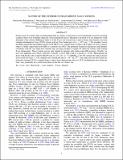NATURE OF THE EXTREME ULTRALUMINOUS X-RAY SOURCES
Author(s)
Wiktorowicz, Grzegorz; Belczynski, Krzysztof; Sobolewska, Malgorzata; Sadowski, Aleksander B
DownloadWiktorowicz-2015-NATURE OF THE EXTREM.pdf (751.5Kb)
PUBLISHER_POLICY
Publisher Policy
Article is made available in accordance with the publisher's policy and may be subject to US copyright law. Please refer to the publisher's site for terms of use.
Terms of use
Metadata
Show full item recordAbstract
In this proof-of-concept study we demonstrate that in a binary system mass can be transferred toward an accreting compact object at an extremely high rate. If the transferred mass is efficiently converted to X-ray luminosity (with disregard of the classical Eddington limit) or if the X-rays are focused into a narrow beam, then binaries can form extreme ultraluminous X-ray (ULX) sources with an X-ray luminosity of L[subscript X] ≳ 10[superscript 42] erg s[superscript -1]. For example, Lasota and King argued that the brightest known ULX (HLX-1) is a regular binary system with a rather low-mass compact object (a stellar-origin black hole (BH) or a neutron star (NS)). The predicted formation efficiencies and lifetimes of binaries with the very high mass transfer rates are large enough to explain all observed systems with extreme X-ray luminosities. These systems are not only limited to binaries with stellar-origin BH accretors. Notably, we have also identified such objects with NSs. Typically, a 10 M[subscript ʘ] BH is fed by a massive (~10 M[subscript ʘ]) Hertzsprung gap donor with Roche lobe overflow (RLOF) rate of ~10[superscript -3] M[subscript ʘ] yr[superscript -1] (≈2600[. over M][subscript Edd]). For NS systems the typical donors are evolved low-mass (~2 M[subscript ʘ]) helium stars with RLOF rate of ~10[superscript -2] MM[subscript ʘ] yr[superscript -1]. Our study does not prove that any particular extreme ULX is a regular binary system, but it demonstrates that any ULX, including the most luminous ones, may potentially be a short-lived phase in the life of a binary star.
Date issued
2015-08Department
MIT Kavli Institute for Astrophysics and Space ResearchJournal
The Astrophysical Journal
Publisher
IOP Publishing
Citation
Wiktorowicz, Grzegorz, Małgorzata Sobolewska, Aleksander Sadowski, and Krzysztof Belczynski. “NATURE OF THE EXTREME ULTRALUMINOUS X-RAY SOURCES.” The Astrophysical Journal 810, no. 1 (August 25, 2015): 20. © 2015 The American Astronomical Society
Version: Final published version
ISSN
1538-4357
0004-637X